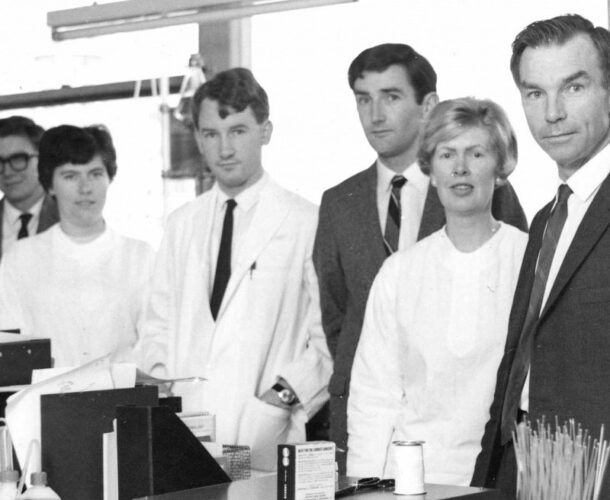In the years that follow the publication of The Autoimmune Diseases in 1963 “intense effort was put into identifying which autoantibody was characteristic of which disease.”1
In this effort, head of the Clinical Research Unit Professor Ian Mackay was “joined for a quarter of a century by Dr Senga F Whittingham, whose mastery of techniques for measuring antibodies made her an invaluable collaborator.”1
Autoimmune hepatitis antibody clue
In 1966, Whittingham discovers that 81 per cent of patients with autoimmune hepatitis have autoantibodies that bind to a type of muscle fibre called smooth muscle.
As Nossal later explained:
“Now, autoimmune hepatitis is in no way a muscle disease. The antibodies reacted with the insides of the smooth muscle cells as studied in a thin slice or section of the muscle put under the microscope. In this case the antibody is not the cause of the disease, it is simply a marker.”1
World leaders in autoimmunity
By 1967 Whittingham’s serology laboratory had been designated a World Health Organization reference laboratory for autoantibodies.
The Clinical Research Unit under Mackay, and later Professor Len Harrison, altogether identified about a dozen kinds of antibodies as characteristic of various diseases. The number has expanded enormously since then.
Nossal wrote that the laboratory made many significant contributions to better understanding autoimmune diseases and identifying autoantibodies for these diseases.
“As techniques improved, the unit mounted a frontal attack on the molecular definition of the target molecules for autoantibodies. In the mid to late 1980s this yielded a rich harvest.1
“The first molecular definition made by Jane McNeilage and Senga Whittingham was a protein… derived from a portion of the chromosomes of the nucleus known as the centromere. Antibodies to this are associated with one type, the so-called CREST variant, of a nasty disease known as scleroderma. The group was strengthened by an outstanding sabbatical leave visitor Eric Gershwin, and Ross Coppel, a card-carrying gene cloner, and a whole range of target molecules was purified. This work continued vigorously after Mackay’s retirement in March of 1987. It has made diagnosis of autoimmune syndromes much more precise.”
“In many instances, however, the autoantibodies are not the culprits, and the damaging agent is an autoimmune cytotoxic T lymphocyte.”1
This was certainly found to be the case in type 1 diabetes. A killer T cell was identified which later became the life work of Professor Len Harrison in his quest to develop a vaccine for type 1 diabetes.



